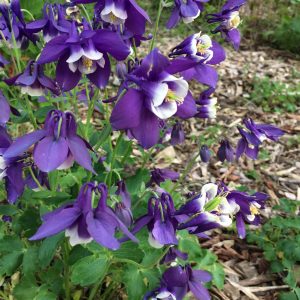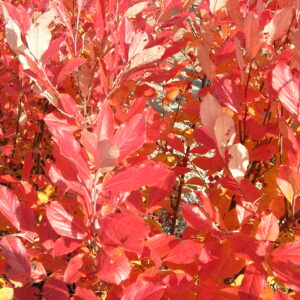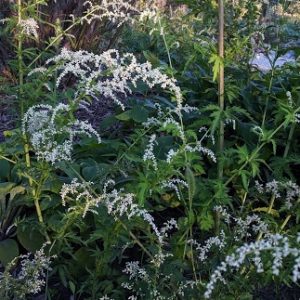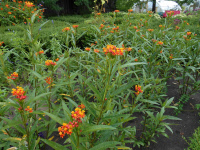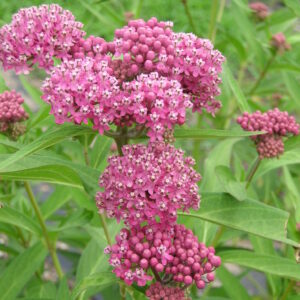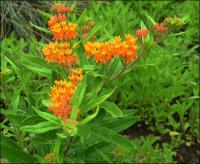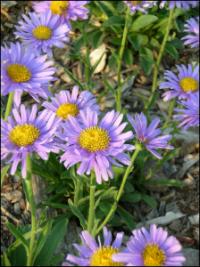Plants for Butterflies and Other Pollinators
Showing 17–24 of 211 results
-
Aquilegia flabellata v. pumila syn. Aquilegia flabellata ‘Nana’, Aquilegia fauriei Dwarf Fan columbine Z 4-9
April-May lilac blooms of nodding lilac-blue to purple sepals with white petals on compact mound of blue-green foliage
OUT OF STOCK
April-May lilac blooms of nodding lilac-blue to purple sepals with white petals on compact mound of blue-green foliage
Size: 6-9” x 9-12”
Care: sun to part shade in moist well-drained soil, Deadhead for rebloom
Native: Japan
Wildlife Value: deer and rabbit resistant. Attracts butterfliesLatin word flabellatus mean fanlike referring to leaflet shape. First published as Aquilegia buergeriana var. pumila in Swiss journal Bulletin de l’Herbier Boissier 5: 1090. 1897.
-
Aronia arbutifolia Red chokeberry syn. Photinia pyrifolia SHRUB Z 5-9
Corymbs of white in spring, gorgeous red foliage in fall compliments the red berries that persist into winter
OUT OF STOCK
Corymbs of white in spring, gorgeous red foliage in fall compliments the red berries that persist into winter
Size: 6-8' X 3-5'
Care: sun to part shade in moist to well-drained acidic soil. Prune annually in late winter to promote vigorous growth.
Native: Nova Scotia west to Ontario south to TX & FL
Wildlife Value: Berries overwinter-food for Thrush, Oriole, and Cedar waxwings.Showy shrub collected by André Michaux around 1800. Aronia comes from aria a subgenus of a related plant, Sorbus. Arbutifolia means “leaves like the Arbutus.” William Robinson, father of mixed borders, reported: “Massed, charming both in flower and fine color of leaf in autumn.”
-
Artemisia frigida Prairie sagewort, Silky wormwood Z 3-10
Erect stems bear silvery-white, finely-divided foliage. Leaves smell like camphor. Inconspicuous yellow flowers bloom in summer.
OUT OF STOCK – EMAIL FOR AVAILABILITY
Erect stems bear silvery-white, finely-divided foliage. Leaves smell like camphor. Inconspicuous yellow flowers bloom in summer.
Size: 6-18” x 12-18”
Care: sun in well-drained soil. Drought tolerant.
Native: all North America except the SE, CA and OR, Wisconsin native
Wildlife Value: source of nesting material for native bees, food for caterpillars of several butterflies & moths
Awards: Royal Horticultural Society Award of Garden MeritNative Americans used this Artemisia to preserve meat, feed horses, repel insects, to remedy toothache, headache, coughing, lung ailments, heartburn, and colds. Indians in Great Basin used it in ceremonies. Chippewa made a decoction of root for convulsions. For the Lakota this was “women’s medicine” with an infusion helping regulate menstrual periods and induce contractions in pregnancy.
Meriwether Lewis collected this along the Missouri River in South Dakota on October 3, 1804. -
Artemisia lactiflora White mugwort Z 3-8
Plumes of creamy white, resembling an astilbe, above foliage blackish-green on one side and silver on the other side, Blooms August to October
OUT OF STOCK – EMAIL FOR AVAILABILITY
Blooms in plumes of creamy white, resembling an astilbe, above foliage blackish green on one side and silver on the other side. Blooms August to October.
Size: 4-5’ x 1.5-2’
Care: sun to part shade in moist, well-drained soil.
Native: East asia-China
Wildlife Value: attracts butterflies & bees. Rabbit and Deer tolerant
Awards: Royal Horticultural Society Award of Garden MeritGenus is named for Artemis, Greek goddess of the moon, wild animals, and hunting. Lactiflora means “milk-white flowers”
Used in traditional Chinese medicine to treat menstrual & liver disorders, and reduce inflammation. Southeast Asians cook with its leaves and tender stems boiled or stir fried and added to soups. 1st described in Western literature 1837.
-
Asclepias curassavica Bloodflower or scarlet milkweed Z 9-11 Annual in colder areas
Small scarlet red and orange umbels all summer and early fall
OUT OF STOCK
Asclepias curassavica grows upright and tall with spiraling lance-shaped leaves. Blooming all summer and early fall. Showy flowers, in small scarlet red and orange umbels.
Size: 24-30” x 12-24”
Care: sun to part shade in moist well-drained soil
Native: South America
Wildlife Value: Attracts Monarch butterfliesIn gardens since 1750’s.
-
Asclepias incarnata Swamp milkweed Z 3-9
Fragrant medium pink umbels, like an upside down ballerina’s skirt, July – September. One of internationally known garden designer Piet Oudolf’s 100 “MUST HAVE” plants, Gardens Illustrated 94 (2013)
Fragrant medium pink umbels, like an upside down ballerina’s skirt, July – September. One of internationally known garden designer Piet Oudolf’s 100 “MUST HAVE” plants, Gardens Illustrated 94 (2013)
Size: 3’-4’ x 2-3’
Care: Sun in moist to moist well-drained soil
Native: North America – all states except those along the Pacific Coast – Wisconsin native.
Wildlife Value: host for Monarch caterpillars, flowers are source of nectar for several butterfliesNamed after Asclepias, a Greek god of medicine. Native American groups used Swamp milkweed – Chippewa to increase their strength & the stems made into twine; Iroquois to heal navels in babies, to increase or decrease urine and to make a person strong enough to punish witches; Meskwaki to drive out tapeworms; and Menominee used it as an ingredient in food – added to deer soup & cornmeal mush. Oneida used the root to remedy asthma and whooping cough. They made thread to sew moccasins with the stems. Lakota Sioux: “The pulverized root is made into a salve which is used to treat swollen glands. The young seed pods are edible after cooking. An infusion of the roots is used to treat asthma, rheumatism, syphilis, and a weak heart.” Listed as growing in England in Philip Miller’s Gardeners’ Dictionary, 1768. Grown at America’s 1st botanic garden, Elgin Botanic Garden 1811. Pressed specimen in Emily Dickinson’s herbarium. “The downy parachutes . . . attached to each seed are six times more buoyant than cork and five times warmer than wool. Large quantities of milkweed were grown for use as stuffing in pillows and lifejackets during World War II.” USDA Natural Resources Conservation Service.
-
Asclepias tuberosa Butterfly weed, Pleurisy-root Z 4-9
Gorgeous - July - September bright orange cymes
OUT OF STOCK
Gorgeous – July – September bright orange cymes
Size: 2-3' x 12"
Care: Sun in well-drained to moist well-drained soil
Native: East and south North America, Wisconsin native
Wildlife Value: Host for Monarch caterpillars and its nectar is a favorite for 13 different butterflies: 4 Swallowtails, 2 Fritillaries, Checkered white, Spring azure, Small copper, Sachem, Monarch, and Coral and Gray hairstreaks. Attracts Ladybugs that eat many insect pests.
Awards: Great Plants for Great Plains; Perennial Plant Assn. Plant of the Year 2017.Named after Asclepias, a Greek god of medicine. Omaha Indians ate the raw root to cure bronchial and pulmonary ailments, their Shell Society was the authorized guardian of the plant, taking 4 days to dig, prepare and distribute the root. Most important medicine for Menominee Indians. The Iroquois smashed roots on legs to impart strength to runners. Navajo cured coyote bites and flu with Butterfly weed. HoChunk placed masticated root into wounds. Collected and sent to England by Rev. John Banister in colonial Virginia c. 1680. Cultivated by Jefferson. Pressed specimen in Emily Dickinson’s herbarium.
-
Aster alpinus Alpine Aster Z 5-7
Frilly little daisies, May-June, lavender, pink or white
Frilly little lavender daisies, May-June. Plant where they will be seen in the front of the garden.
Size: 6" x 12"
Care: Full sun well-drained soil.
Native: Rockies
Wildlife Value: attract butterflies
Awards: England’s Royal Horticultural Society Award of Merit.
Size: Border/Rock gardensAster means star, referring to the flower’s form. Listed in Philip Miller’s Gardeners’ Dictionary 1768: “Grows naturally upon the Alps… at the top of each stalk is one large blue flower…this flowers in June…”

